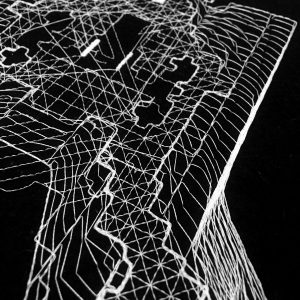
Is typography dead?
If you think that typography is all about technique and skills, you miss out on its true potential.

Try to read the first text. If you get lost, read the second one.
Hierarchy: what is important? If I start writing like this and I have some important and some less important things to tell you, then what can I do to make that visual? As a typographer, you can organise the text in a visual way so it doesn’t take too much time for the reader to find her way. This is called hierarchy, which is the most important element in typographic design. It deals with composition and balance. It works on different levels. If you know that people don’t read letters, but words, then we could also state that they don’t read words, but read text. The word reading can then replaced by looking at. First level is the content of the text. If this is not organised well, there is no way you can apply hierarchy. Once I send a text back to the client with the comment to rewrite it. There was really no way I could work with it. Second level is adding white. Paragraphs will break up the text in readable pieces which gives direction to the reader. White space also gives the reader a moment to contemplate. Third: the choice of typeface. What hierarchic needs are there? In this text, I use a big family that has many different styles and weights, called IBM Plex. However, it can be a nice challenge and exercise to apply hierarchy using one typeface, one weight, one style and one size. Fourth level is to apply different typefaces, weights, widths and styles: serif – sans-serif, thin – ultra black, compressed – expanded, italic – small caps. The way you choose to apply these is your own aesthetic preference. However, one thing is important: be consequent. If you decide to use italic for titles, do it everywhere. Don’t confuse the reader, you will loose her fast. Last but not least: adding visual elements like color , boxes, lines, underline / inline / outline. And don’t forget the use of caps! Did you hear me shout? That’s the theory, now let’s practise.
Got bored? Take 2. Same text, different hierarchic design.
What is important?
If I start writing like this and I have some important and some less important things to tell you, then what can I do to make that visual?
As a typographer, you can organise the text in a visual way so it doesn’t take too much time for the reader to find her way.
This is called hierarchy, which is the most important element in typographic design.
It deals with composition and balance.
It works on different levels.
If you know that people don’t read letters, but words, then we could also state that we don’t read words, but read text. The word reading can then replaced by looking at.
First level is the content of the text. If this is not organised well, there is no way you can apply hierarchy.
Once I send a text back to the client with the comment to rewrite it. There was really no way I could work with it.
Second level is adding white. Paragraphs will break up the text in readable pieces which gives direction to the reader. White space also gives the reader a moment to contemplate.
Third: the choice of typeface. What hierarchic needs are there? In this text, I use a big family that has many different styles and weights, called IBM Plex.
However, it can be a nice challenge and exercise to apply hierarchy using one typeface, one style, one weight and one size.
Fourth level is to apply different typefaces, weights, widths and styles: serif – sans-serif, thin – ultra black, compressed – expanded, italic – small caps.
The way you choose to apply these is your own aesthetic preference. However, one thing is important: be consequent. If you decide to use italic for titles, do it everywhere. Don’t confuse the reader, you will loose her fast.
Last but not least: adding visual elements like color , boxes, lines, underline / inline / outline.
AND DON’T FORGET THE USE OF CAPS!
Did you hear me shout?
That’s the theory. Now:

If you think that typography is all about technique and skills, you miss out on its true potential.

Teaching typography is complicated, because talking about typography easily becomes a conversation about taste.